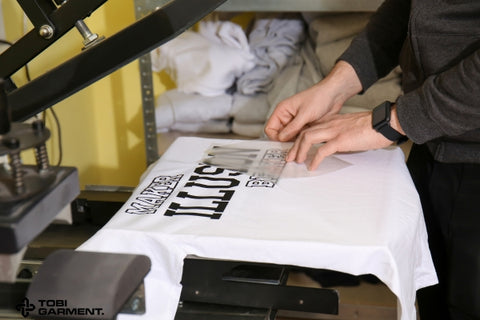
Are you excited to dive into the world of screen printing and create your own custom t-shirts from the comfort of your home? Look no further! This comprehensive guide will walk you through everything you need to know to get started with screen printing at home.
What is Screen Printing?
Screen printing, also known as silk screening, is a printing technique that uses a mesh screen to transfer ink onto a substrate, typically fabric like t-shirts. It allows you to create vibrant, long-lasting designs with a professional touch.
Why Start Screen Printing at Home?
Starting a screen printing business at home offers numerous benefits:
- Flexibility: Work on your own schedule and create designs that reflect your unique style.
- Cost-effectiveness: Avoid the overhead costs of renting a commercial space.
- Creative freedom: Unleash your imagination and bring your design ideas to life.
- Potential for profit: Turn your passion into a profitable venture by selling custom t-shirts.
Read more: Easily Convert Any Color to Pantone Color - Precise Color Matching
Essential Equipment for DIY Screen Printing
To begin your screen printing journey at home, you'll need the following essential equipment:
Screen Printing Press
A screen printing press is the foundation of your setup. It holds the screen and allows you to align your t-shirt for printing. You can choose from manual or automatic presses, depending on your budget and skill level.
Exposure Unit
An exposure unit is used to transfer your design onto the screen. It exposes a light-sensitive emulsion coated on the screen, creating a stencil for the ink to pass through.
Ink
Select high-quality screen printing inks that are compatible with the fabric you'll be printing on. Popular options include water-based and plastisol inks.
Stencil
The stencil is the negative space of your design that allows the ink to pass through the screen. You can create a stencil using photo emulsion or films.
Other Supplies
- Squeegee: Used to push the ink through the screen and onto the t-shirt.
- T-shirts: Choose high-quality blank t-shirts that fit your target market.
- Cleaning supplies: Includes degreaser, screen printing emulsion remover, and mesh opener.
Read more: A Beginner's Guide to Screen Printing on Garments
Design Basics for Screen Printing
Before you start printing, it's essential to understand the basics of design for screen printing. Here are some key points to keep in mind:
Understanding Design Principles
- Keep designs simple: Complex designs with small details may not translate well to screen printing.
- Use high-contrast colors: Opt for colors that stand out against the t-shirt fabric.
- Consider the placement: Decide where you want your design to appear on the t-shirt.
Creating Your Own Designs
You can create your own designs using graphic design software like Adobe Illustrator or Photoshop. Alternatively, you can hire a designer to create custom artwork for you.
Finding Inspiration
Explore online galleries, social media, and t-shirt design websites to find inspiration for your own creations. Observe trends and popular designs in your target market.
Step-by-Step Guide to Screen Printing
Now that you have your equipment and design ready, let's dive into the step-by-step process of screen printing at home:
Preparing Your Design
Create your design in vector format (e.g., AI, EPS, or SVG) for best results.
Print your design onto a transparency film using a high-resolution printer.
Exposing the Stencil
- Coat the screen with a light-sensitive emulsion and let it dry in a dark room.
- Place the transparency film with your design on the screen and expose it to UV light using the exposure unit.
- Wash out the unexposed emulsion to reveal your stencil.
Applying Ink
- Place the screen on your printing press and position your t-shirt underneath.
- Apply a generous amount of ink at the top of the screen.
- Use the squeegee to pull the ink across the screen with firm, even pressure.
- Lift the screen to reveal your printed design.
Curing the Ink
- Allow the ink to fully dry before handling the t-shirt.
- Use a heat press or convection oven to cure the ink and ensure it adheres to the fabric.
Washing and Drying T-Shirts
- Wash printed t-shirts inside-out in cold water to preserve the design.
- Hang or tumble dry on low heat.
Read more: Water-Based Screen Printing: A Sustainable and Versatile Art
Tips for Starting a Home-Based Screen Printing Business
If you're looking to turn your screen printing hobby into a profitable business, consider these tips:
Legal Considerations
- Research local business regulations and obtain necessary permits and licenses.
- Register your business and set up a separate bank account.
Marketing and Sales
- Create a strong online presence through a website and social media channels.
- Participate in local craft fairs, markets, and events to showcase your products.
- Develop a unique brand identity that sets you apart from competitors.
Pricing and Profitability
- Track your expenses for materials, equipment, and labor.
- Set prices that cover your costs and include a profit margin.
- Use accounting software to monitor your income and expenses.
Building a Customer Base
- Network with other small businesses and local influencers.
- Engage with your audience on social media and offer promotions and discounts.
- Prioritize excellent customer service to build loyalty and encourage repeat business.
Read more: Screen Printing Hoodies: A Step-by-Step Tutorial for DIY Enthusiasts
FAQs
What is the best ink for screen printing t-shirts at home?
The best ink depends on the fabric you're printing on. Water-based inks are great for soft, breathable prints, while plastisol inks offer a more durable finish.
How long does it take to learn screen printing?
Learning the basics of screen printing can take a few hours to a day, depending on your experience with similar crafts. Mastering the technique takes regular practice and experimentation.
Can I screen print on dark t-shirts?
Yes, you can screen print on dark t-shirts, but you'll need to use a white or light-colored ink base to ensure the design stands out.
How much does it cost to start a screen printing business at home?
The initial investment can vary depending on the equipment and supplies you choose. You can start with a basic setup for around $500-$1000 and gradually expand as your business grows.
Do I need a license to sell screen printed t-shirts?
Most likely, yes. Check with your local authorities to determine if you need a business license, sales tax permit, or any other legal requirements to sell your products.
Conclusion
In conclusion, starting a screen printing business at home is an exciting and rewarding venture. With the right equipment, design skills, and business savvy, you can turn your passion into a profitable enterprise. Remember to always prioritize quality, creativity, and customer satisfaction as you embark on your screen printing journey. Happy printing!
Read more related posts from Tobi Garment:



